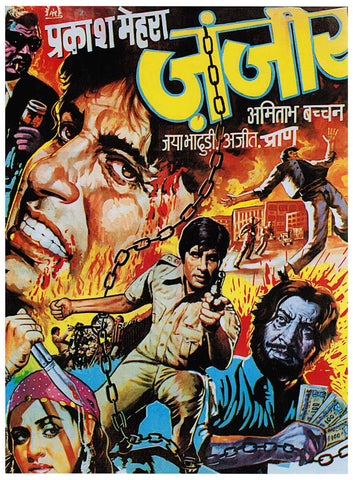
In this article, we trace the making of that persona — from Zanjeer to Deewar — and argue how it still resonates in cinema and culture today.
The Birth of the Angry Young Man: Zanjeer (1973)
Before Zanjeer, Hindi films were dominated by romantic heroes, melodrama, and sentimental arcs. The idea of a protagonist who thundered at the system was unusual. But Zanjeer, directed by Prakash Mehra, changed that. The film introduced Inspector Vijay — burdened, incandescent, morally infuriated.
Interestingly, the “Angry Young Man” concept was largely shaped by Salim Khan, who wrote the original script. Though later credited under the Salim-Javed partnership, Salim has claimed he alone conceptualized the role in Zanjeer. The Indian Express
At the time, many established actors rejected the role. Whether because it diverged from the romantic hero mold or caused them discomfort, names like Rajesh Khanna, Dev Anand, Dharmendra, Raaj Kumar all passed on it. Bachchan — then not yet a sure bankable box office draw — accepted.
Despite Bachchan’s own doubts — as later revealed by Javed Akhtar — the film succeeded and resonated because audiences recognized something real in Vijay’s anger.
One of the most famous lines from Zanjeer captures the ethos:
“Jab tak baithne ko na kaha jaaye, sharafat se khade raho. Yeh police station hai, tumhare baap ka ghar nahin.”
(“Until you are told to sit, stand upright with dignity. This is a police station, not your father’s house.”)This moment snapped something in the public imagination.
From Breakthrough to Icon: Deewar (1975) and Its Aftershocks
If Zanjeer was the spark, Deewar was the conflagration. Directed by Yash Chopra and written by Salim-Javed, Deewar pushed the angry hero into mythic dimensions. Bachchan’s Vijay, fighting fate and betrayal, became an avatar of despair, rage, and defiance.
Audiences saw in Vijay a man alienated by circumstances, denied justice, dragging his rage across class lines. The film’s clash between brothers — one a lawman, one a rebel — made public justice and personal vendetta two sides of the same coin. ejumpcut.org
In the years since, Deewar is often cited as a turning point in Hindi cinema — the moment when the “Masala” template matured into something deeper: ideology inside action, morality folded into vengeance.
For Bachchan, Deewar enshrined him as the era’s defining icon. Many commentators say that Deewar was what made him a “one-man industry”—a star whose presence could shift cinematic tides.
Why It Worked: Rage, Resonance & Repetition
- Emotional authenticity
- Social catharsis
- Narrative template & its iterability
From Rage to Reflection: Later Phases of Bachchan’s Legacy
Of course, Bachchan’s career did not remain locked in rage. Over decades, he diversified — he played romantic leads, comedic roles, father figures, voice roles, and even reflections on mortality.
Yet even in later films, echoes of the angry man persist — in the moral weight he brings to Sarkar, Pink, Piku, Black. The earlier persona became a kind of subtext, a legacy he could evoke or resist.
In 2024, the documentary miniseries Angry Young Men premiered, tracing the careers of Salim and Javed and reflecting on their partnership with Bachchan.
Conclusion: Why Write About This on His Birthday?
As we mark 11 October, celebrating Amitabh Bachchan’s life, it is tempting just to catalog his awards and box office hits. But what makes him mythic is how his films intersected with public emotion. The “Angry Young Man” isn’t just a label — it’s a cultural code that continues to be decoded, contested, and reinterpreted.
For your readers, you can argue: • That Bachchan’s rage was never gratuitous but symbolic. • That his angry man image emerged in a specific historical moment but transcended it. • And that modern Indian cinema still speaks the grammar he catalyzed — whether in vigilante thrillers, moral dramas, or anti-hero narratives.